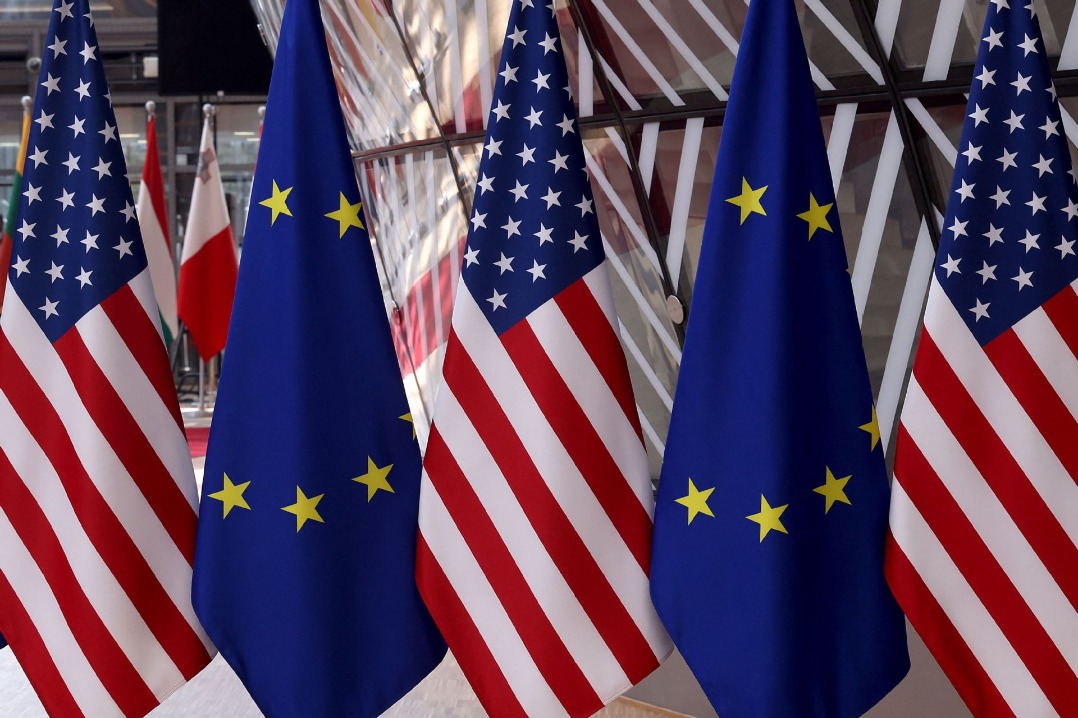A place of sanctuary and creativity
Exhibition sheds light on Chongqing's influence on modern art and celebrates the spirit of a city that offered wartime resistance during WWII and spectacular scenery, Lin Qi reports.

In the spring of 1939, people flocked to take refuge in Chongqing, in Southwest China, amid the chaos caused by the War of Resistance Against Japanese Aggression (1931-45). Among them there was Fu Baoshi (1904-65), a university teacher of Chinese painting, and his family, who settled down in a shabby countryside cottage, in a mountain suburb known as Jingangpo among the locals. Today it is located in the Shapingba district. Fu lived there for more than seven years and, during this time, his reputation soared. In the years spent in the small, dark cottage, his career underwent a major transition, as he rose from a lesser-known artist to a prominent figure in landscape painting.
Fu was deeply immersed in the majestic landscape of Chongqing, with its mountains of wild, eccentric beauty, lush greenery and dense mist, which, along with the clouds, added a feeling of extensiveness and mystery. The scenery he saw every day inspired him to establish a highly individual style in the mountain-and-water genre of Chinese painting, and to also form the "Baoshi cun", later widely known as his signature brushstroke approach.
Cun is a method of dabbing, shading and layering in Chinese painting to create the form, surface and texture of rocks and mountains. And Fu further reformed this technique in his work to accentuate the fissures and cracks in the mountain stones and the high humidity of Chongqing, a riverside, mountainous city. This approach is sometimes called "Jingang cun", named after Jingangpo.
The progress in art Fu achieved in Chongqing continued to influence his later work, even after he left the city and moved back to Nanjing, in today's Jiangsu province, where he taught, painted and pioneered the "new landscape painting" movement.
Fu's intimate link with Chongqing is marked at a group exhibition in Beijing, Splendent Galaxy, which reviews important figures, schools, movements and publications active in Chongqing, between 1937 and 1949, a period that established a chapter of modern Chinese art. Organized by the Sichuan Fine Arts Institute, in Chongqing, the exhibition is on at Today Art Museum until April 13.
Chongqing, tucked in the Sichuan Basin where the majestic Yangtze River runs, was not only the temporary wartime capital of the Kuomintang government. It was also a hub of celebrated artists, schools and cultural institutions whose presence there helped stoke the embers of modern Chinese art amid the fire and smoke of World War II, and their accomplishments helped, in part, to shape the country's art scene in the decades following the war.
Besides Fu, featured artists at the exhibition also include Xu Beihong, another luminary of 20th-century Chinese art who, while in Chongqing, depicted the plight of ordinary people during wartime and living in poverty, held exhibitions and opened up lectures to motivate people not to give up the struggle against the Japanese invaders and continue the fight for national independence.
In the latter years of his life, Xu often recalled his time in Chongqing, according to his wife Liao Jingwen (1923-2015) who once said, "in paintings he created, he inscribed places of Chongqing, such as Hualongqiao and Panxi. He developed a strong attachment to the city while he was there".
Xu Ji, a grandson of Xu Beihong and a chief curator of the exhibition, says the title is derived from Guan Canghai (Behold the Dark Green Sea), a poem attributed to Cao Cao, a statesman, military commander and poet living in the second and third centuries, referring to Chongqing's scenic magnificence and the courage of its people in the face of national crises.
"The city became a shelter and a center for those who evacuated from other parts of the country that were occupied by the Japanese. They made art, rebuilt schools, held exhibitions, formed groups and founded publications," says Xu Ji. "Through all sorts of activities, they voiced the pain and courage of the people and their nation.
"Therefore, this show is a tribute to the greatness of art, and to the social responsibilities artists undertook in a challenging period of time."
In his painting, Xu Beihong often detailed the difficulties people faced at the time, for example, descending and climbing slippery steps to fetch water from the river, several times a day.
Fu himself had firsthand experience of these daily hardships. His rented accommodation in Chongqing lacked sufficient space, and was poorly lit.
He once recalled that, when he painted, he had to move the table closer to the door and open it to let in more light to be able to work. That table was where his family ate and upon which he painted several great works; when he painted on the table, he had in his sight, through the open door, an expansive view of bamboo forests, streams and hills. He interpreted, under layers of colors, the scenes before his eyes and embedded in the mountains and trees an unyielding spirit.
Fu once said, "Jingangpo and its neighboring areas, which I visited quite often, produced scenery of unspeakable brilliance. The trees, woods, hills and valleys are all perfect models for sketching. The extraordinary scenery, often half disappearing in the mist, shows a realm of nature that is beyond the knowledge of a person, like me, who lives in southeastern part of the country and is accustomed to the landscape there."
Despite the difficulties caused by war, more than 500 exhibitions were staged in the city. There was a national art exhibition in 1943 showing modern works and antiquities, including bronzes, jade objects and lacquerware, and another show of paintings in 1945 focused on modernism, making it a landmark event at the time.
Chongqing was also instrumental in the rediscovery of Dunhuang: From 1940 to 1945, a survey team, consisting of historians, artists and archaeologists, set out from the city for the hinterland of the northwest, and investigated the Dunhuang grottoes, in what is now Gansu province, and other historical sites along the way. They held an exhibition in Chongqing in 1943 to show the public the glories of Dunhuang and the country's ancient artistic and cultural heritage.
He Guiyan, a professor at the Sichuan Fine Arts Institute, says that the exhibition reveals a panoramic picture of Chongqing and its cultural landscape in the 1930s and '40s, adding that it introduces to people the cultural accumulations of this southwestern city, and how it kept fanning the flame of Chinese art and culture.






Today's Top News
- Agreement boosts ocean governance
- Experts: Punishments law misinterpreted
- Project weaves global map of silk's grand history
- Cross-border research work bearing fruit
- Disrupting market under fabricated veneer of 'national security' hurts US' own interest: China Daily editorial
- Yasukuni visit would add insult to injury: China Daily editorial






























